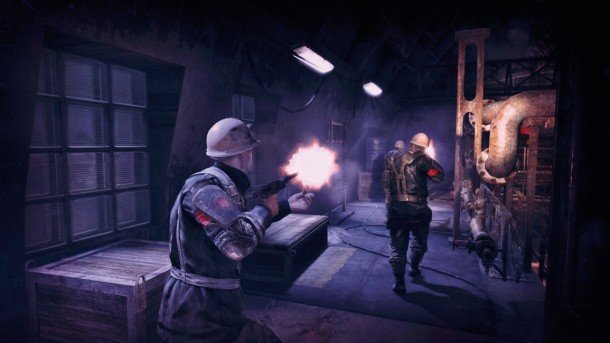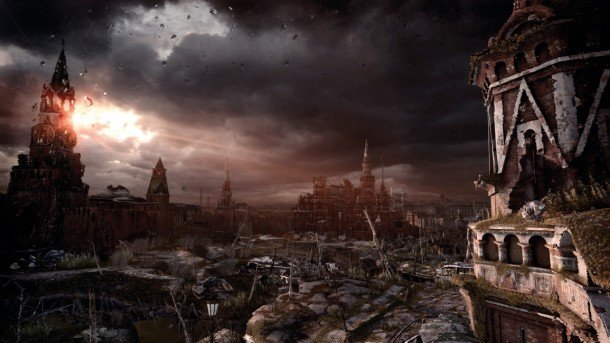Metro: Last Light preview - we venture deep into 4A Games' gloomy Muscovite shooter

Last Light isn't a dedicated stealth game, and therefore doesn't feature the full mechanical complexity of Hitman or Dishonored – you won't be hiding bodies or hacking turrets or approaching levels from a dozen possible angles. But its focus on simple details – the fact that it lacks typical stealth game accoutrements like maps and a HUD – give it a naturalism that's appealing in its own right. Last Light is more about lots of small, interesting interactions with the world, rather than making and executing grand plans.
Those small interactions are the key to the game's loftier ambitions. Metro 2033's morality system will return with alterations that THQ and 4A aren't yet willing to disclose – indeed, Beynon asks that the press give away as little as possible about the specific ways in which the game will track and respond to the choices that the player makes in the game. Metro 2033 undersold its morality system to the extent that many players had no idea it was there, but Beynon argues that 'gamifying' ethics with clear-cut 'choose your alignment' moments undermine the whole concept.
This also applies to anyone who played through the first game with a guide in order to 'beat' the morality system. “They've missed the point entirely,” Beynon says. “It's almost a hilarious joke. It's like following a recipe without understanding what it is that you're making.”

“The things that take place in the environment should be consistent and believable,” Beynon continues. “As you introduce that, people will think about the way they perceive the game-world that they've been asked to play in. I think we do a really good job of humanising all of the people that you fight against.”
The hope is that by convincing the player of the verisimilitude of the world, the decisions they make will be more genuine – and more meaningful – than those offered by a traditional RPG.
The idea of providing room for more satisfying choices has also informed Metro's weapon system, although in a different way. Where in Metro 2033 the player was limited to three weapons within different categories – sidearms, primary weapons, and secondary special weapons – in Last Light you will be free to mix and match any trio of guns you like. Extensive customisation also frees you to swap out scopes, extended clips, silencers and so on, at the cost of valuable pre-war ammunition that doubles as currency. If you want to tool Artyom out for sniping and stealth, that's up to you: alternatively, you might place your hopes in automatic shotguns and assault rifles.
“You make your choice and you deal with the consequences,” Beynon says. “If you want to, you can play it very safe throughout the game – that's fine, that might be the optimal way to play it. But you might not get to experiment with things that are really fun.”
Keep up to date with the most important stories and the best deals, as picked by the PC Gamer team.

An extraordinary amount of effort has gone into modelling the weapons themselves. Spent casings clink together dynamically as they tumble from a revolver during a reload, a detail demonstrated to me by slowing game-time down to a fraction of its regular speed. Viewing the game this way, it's also possible to pick out the way a spring pushes each new ball-bearing into the chamber of Artyom's pneumatic rifle between shots, and admire the lever mechanism that pulls the next shell into position on a jury-rigged automatic shotgun. Last Light's makeshift weapons are the brainchild of 4A creative director Andrew 'Prof' Prokhorov, whose background in aeronautical simulation gives him the technical expertise to design new firearms that would actually work.
“There's no gamification of the devices that you have,” Beynon says. “That's a contributing factor – if you want to see how much battery you have in your torch, you have to bring up the charger – a physical thing that sits in your hands. The cumulative effect of that detail builds the sense of the world.”
It's also what makes Last Light a contender as a horror game. During another sequence, Artyom drives a tram – made up like a dragster, and covered in lights – through an abandoned area of the subway. The lights keep photosensitive spider monsters at bay (sorry about those, arachnophobes), but if you choose you can stop the car at any point to get out and explore side passages for supplies and secrets. Dynamic lightning in this context means something very different.
Finding a junction box and switching on all the lights in a section is now a huge source of relief, tempered by the sound of a hive full of spider monsters screeching and thrashing in response. It feels like a totally different game to the one where a man darted between campfires, unscrewing bulbs and slitting throats – but it's based on the same mechanics, and it's part of a contiguous experience.

It's easier than ever to think of 'first-person shooter' as an outdated term. The temptation is to break it down into parts – to map out a landscape with your deathmatch blasters over here and your thinking man's sneak-'em-ups over there, your Portal-style spatial puzzlers nestling a healthy distance from DayZ's wide-open survival horror. The problem with this approach is that it downplays the unifying effect that the first-person perspective has: the way that lots of divergent experiences can be made to feel like part of a continuous whole. Game mechanics don't get much simpler or more relatable than 'looking and doing'.
Metro: Last Light is setting out to be many things: realistic shooter, stealth sim, cinematic narrative experience, atmospheric exploration game. Having been shown an extended chunk, though, I don't feel it's quite right to describe it as a hybrid. Instead, the impression I get is of a first-person shooter of an older sort – a linear game with the mechanical variety to support many different approaches and experiences, and the design sense and eye for detail to sustain dramatic shifts in tone, from frantic monster horror to blistering military shooter. It's an old model, in some ways, but a proven one – just ask Half-Life 2.
Whether or not the game can perform to those high standards remains to be seen: but it has something of that old-school sensibility. It's a show that is very much worth stopping to watch.

Joining in 2011, Chris made his start with PC Gamer turning beautiful trees into magazines, first as a writer and later as deputy editor. Once PCG's reluctant MMO champion , his discovery of Dota 2 in 2012 led him to much darker, stranger places. In 2015, Chris became the editor of PC Gamer Pro, overseeing our online coverage of competitive gaming and esports. He left in 2017, and can be now found making games and recording the Crate & Crowbar podcast.


